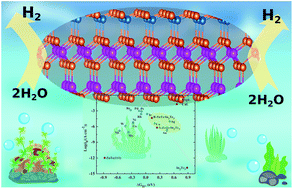Interfacial aspect of ZnTe/In2Te3 heterostructures as an efficient catalyst for the hydrogen evolution reaction†
Abstract
In the class of two-dimensional (2D) materials, group III2–VI3 compounds have drawn intense attention due to its excellent surface properties. In this work, based on first-principles calculations, we have systematically investigated the structural, electronic, optical and photocatalytic properties of a ZnTe/In2Te3 heterostructure, along with its interfacial effects, to design an efficient photocatalyst. We have employed hydrogen adsorption free energy (ΔGH*) as a key parameter to demonstrate the enhancement in photocatalytic activity of ZnTe/In2Te3 compared to a pristine In2Te3 monolayer, which is further verified with the explicit water environment. The underlying mechanism is governed by the partial charge distributions of pristine In2Te3 and ZnTe/In2Te3 heterostructures. The presence of the ZnTe monolayer also altered the bandgap of the In2Te3 monolayer from an indirect gap of 1.238 eV to direct gaps of 0.298 eV and 0.181 eV in A- and B-type interfaces of the ZnTe/In2Te3 heterostructure, respectively. Calculated optical absorption spectra indicate that ZnTe/In2Te3 heterostructures possess better sunlight-harvesting capability compared to monolayer In2Te3 near the infrared and visible light regions, implying their potential as an excellent light-absorber. Our predictions provide new guidance for designing 2D III2–VI3 heterostructures and expand the applications of these materials in photovoltaics, photocatalysts, and other nanodevices in the future.

- This article is part of the themed collection: Journal of Materials Chemistry A Advisory Board Collection


 Please wait while we load your content...
Please wait while we load your content...